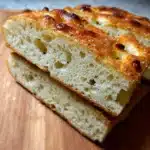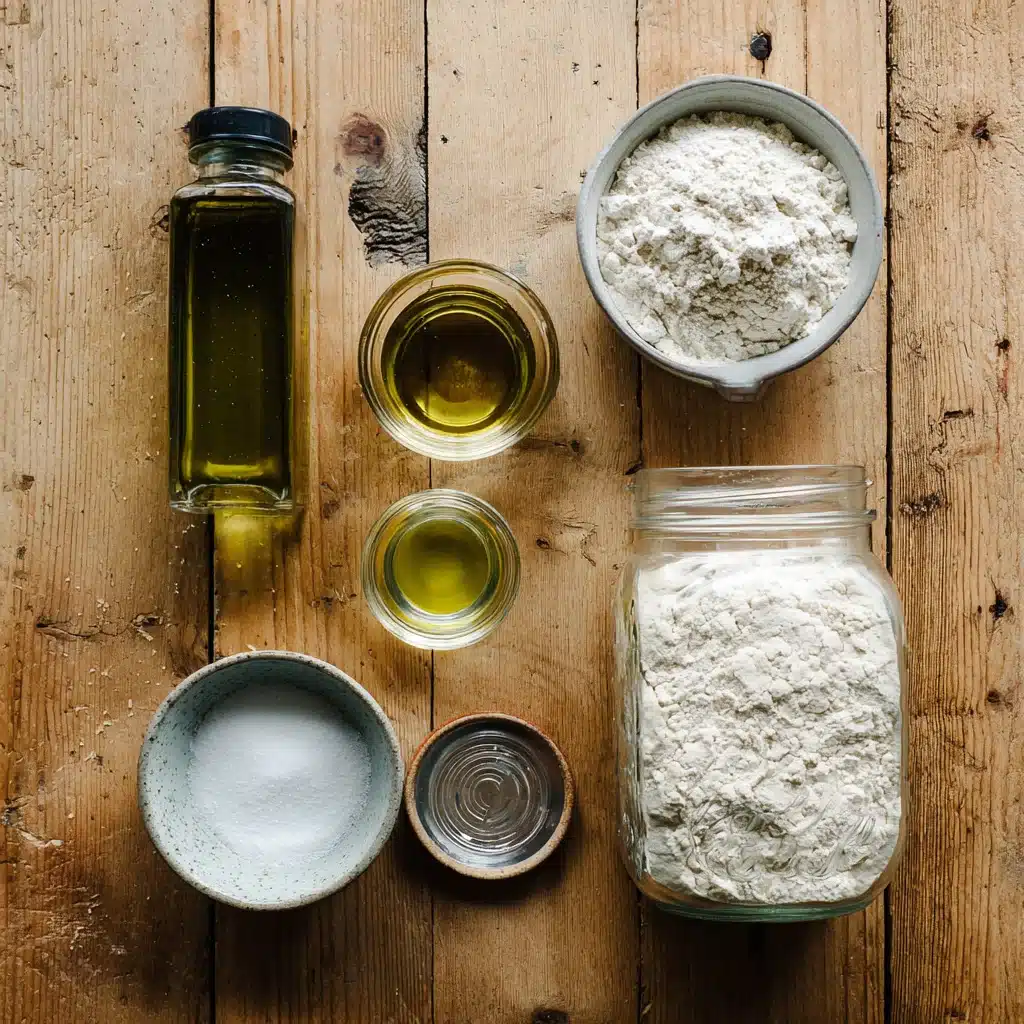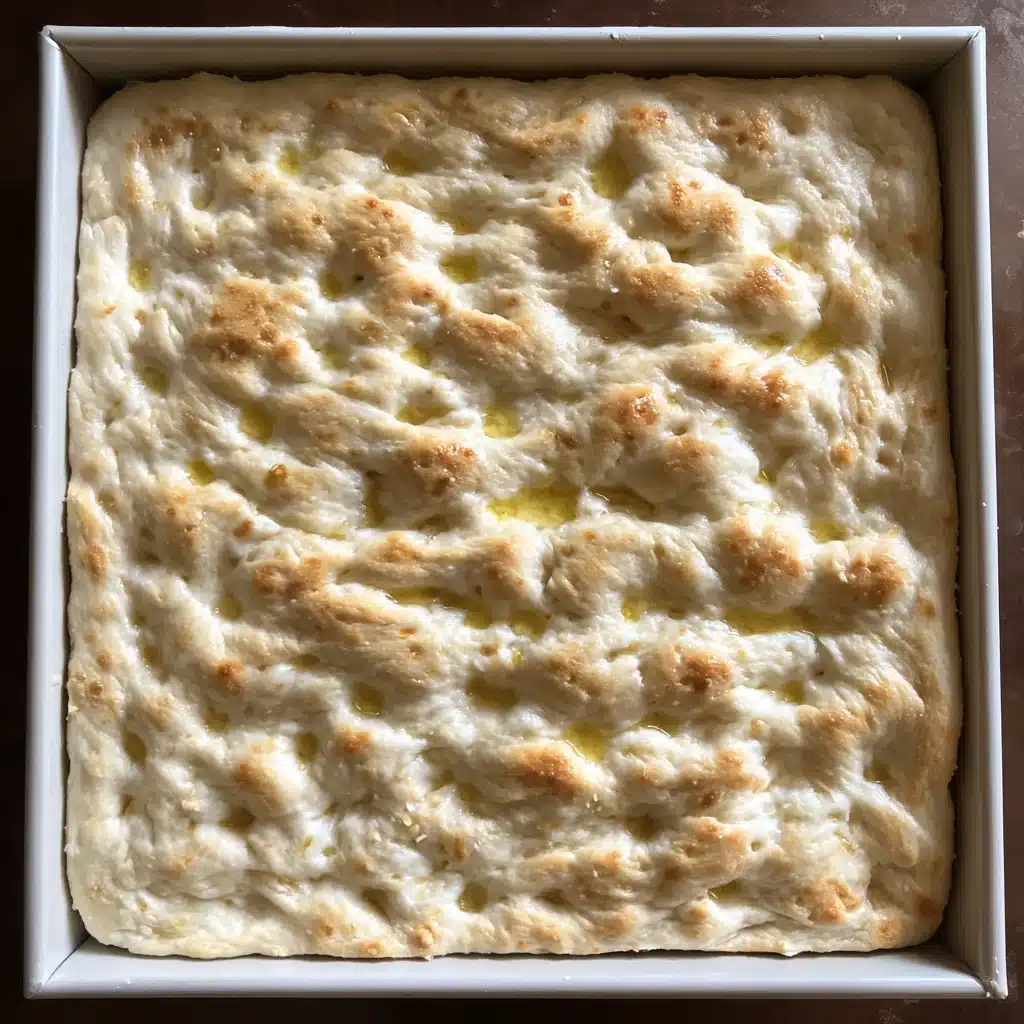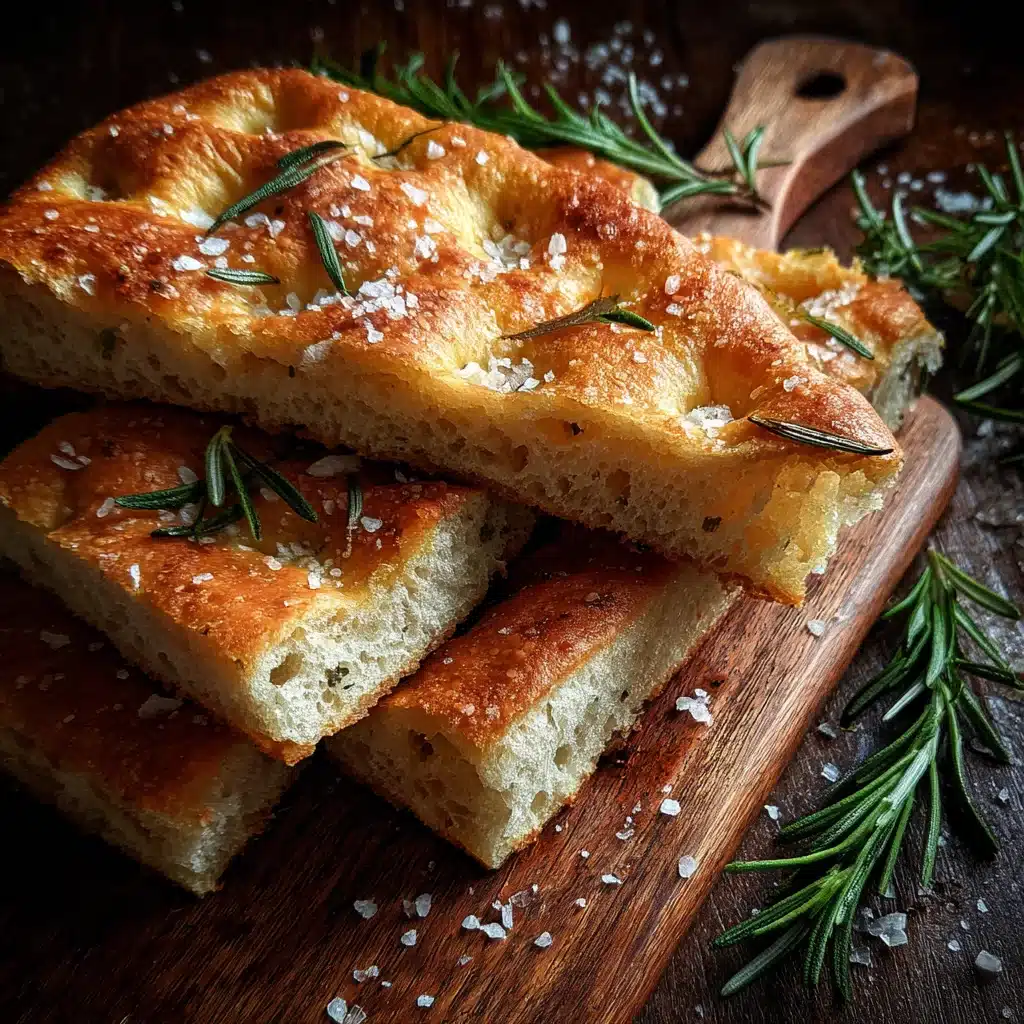There’s something deeply satisfying about a well-made sourdough focaccia. With its olive oil-crisped edges, airy interior, and tangy depth, it’s one of those bakes that works whether your starter is thriving or you’ve got sourdough discard to use. This article walks you through every stage of the process, how to use overproofed dough, why discard focaccia is a thing, and what flour gives you that perfect texture. If you’re craving the kind of focaccia that’s both rustic and refined, you’re in the right place. Plus, I’ll share some lessons I’ve learned the hard way so you don’t have to.
Why I Love Sourdough Focaccia
Turning a Baking Flop Into a Pillowy Win
Hi, I’m Marlene Quinn, baker, mom, and founder of “Marlene & Crumb” in fog-kissed Mendocino, California. My love for sourdough focaccia came not from success, but from a spectacular fail. I had set out to bake a classic country loaf, but I misjudged my proof time. The dough collapsed like a tired balloon. Disheartened but not defeated, I poured the slack dough into a generously oiled pan, let it rest again, and baked it out of desperation. What emerged was something magical, crispy edges, pillowy center, and a golden, olive-oil kissed crust. And just like that, sourdough focaccia became my go-to recovery bake.
That same recipe has evolved since. Now I use it to teach beginner bakers that sourdough doesn’t have to be intimidating. Whether you’re working with bubbling starter or using sourdough discard, focaccia is endlessly forgiving. It’s the perfect place to begin, and even better to revisit when you need a break from precision.
The Magic of Fermentation in Italian Flatbread
There’s a special synergy when Italian simplicity meets slow fermentation. The long, cold proof gives focaccia its flavor while olive oil adds richness and aroma. Salt? That’s your flavor enhancer. And then there’s the choice of flour, bread flour is king here, giving you the structure to hold those signature air pockets. If you’re new to the world of baking focaccia with sourdough, know this: your timeline is your secret ingredient. That overnight fermentation works while you sleep, and the dough rewards your patience.
For an easy intro to fermentation and discard baking, I often point folks to this sourdough discard recipe collection and our guide on sourdough health benefits, both are packed with useful tidbits.
Print
Sourdough Focaccia Recipe – 7 Steps to Crisp, Golden, Perfect Bread
- Total Time: 7 hrs
- Yield: 1 large focaccia 1x
- Diet: Vegetarian
Description
This sourdough focaccia recipe creates a golden, airy flatbread with crispy edges and deep fermented flavor. Perfect for using sourdough discard or saving overproofed dough.
Ingredients
50–100 g active sourdough starter
10 g kosher salt
430–440 g water, room temperature
512 g bread flour
3 tbsp extra-virgin olive oil, divided
Flaky sea salt for topping
Instructions
1. Mix starter, water, and flour until shaggy
2. Rest 30 mins, then add salt and mix again
3. Let bulk ferment 5–6 hours, stretch & fold every hour
4. Coat pan with olive oil, spread dough gently into it
5. Let rest 1 hour, then dimple surface with oiled fingers
6. Top with sea salt, rosemary, or toppings of choice
7. Bake at 450°F for 25–30 mins until golden and crisp
Notes
Use bread flour for best texture.
Can be made with sourdough discard.
Ferment overnight for best flavor.
Oil generously for crispy edges.
- Prep Time: 10 mins
- Cook Time: 25 mins
- Category: Bread
- Method: Baking
- Cuisine: Italian
Nutrition
- Serving Size: 1 slice
- Calories: 170
- Sugar: 0.5g
- Sodium: 360mg
- Fat: 6g
- Saturated Fat: 1g
- Unsaturated Fat: 5g
- Trans Fat: 0g
- Carbohydrates: 25g
- Fiber: 1g
- Protein: 4g
- Cholesterol: 0mg
Keywords: sourdough focaccia, sourdough discard focaccia, baking focaccia

Sourdough Discard Focaccia That Actually Works
Can You Use Sourdough Discard? Absolutely.
If you’ve been baking sourdough for even a week, you’re probably swimming in discard. Good news: sourdough discard focaccia isn’t just a clever waste-saving move, it’s genuinely delicious. This version of sourdough focaccia brings mild acidity, complexity, and character to the dough. It won’t rise as powerfully as active starter, but focaccia doesn’t need towering lift. It craves depth, moisture, and olive oil. Sourdough discard delivers that beautifully.
When using discard, I reduce the hydration slightly and give the dough more time to ferment. Instead of trying to force a fast rise, I let the sourdough focaccia dough sit overnight in the fridge or proof slowly on the counter. The result? A tangy, moist crumb with that golden, olive-oil-kissed crust sourdough lovers crave.
Even better, this is one of those bakes where being flexible pays off. A little extra fermentation time? Great. Want to stretch and fold instead of kneading? Totally fine. Discard-based sourdough focaccia is incredibly forgiving, which is why I teach it to beginners.
Check out more ideas for how to use sourdough discard in our recipe roundup and see how flexible baking can be.
Tips for Flavor and Rise with Discard Dough
Using sourdough discard for focaccia requires a few simple tweaks. First, let your dough ferment long enough, either 8–12 hours in the fridge or 6–8 hours at room temperature. That slow fermentation develops flavor while giving the dough time to build strength. And if your kitchen’s chilly? Add a pinch of yeast to help things along.
Next, stick with bread flour. Its protein content gives sourdough focaccia the chew and support it needs. And always, always be generous with your olive oil, it’s what gives that crisp, fried-bottom crust. I use some in the dough, more in the pan, and a healthy drizzle right before baking.
If you’re looking for more guides like this, take a peek at our complete breakdown on how to bake with sourdough for tips that apply across all sourdough bread recipes.

From Overproofed Sourdough to Irresistible Focaccia
When Your Boule Fails, Sourdough Focaccia Saves It
Every sourdough baker’s been there, your dough looked perfect last night, but this morning it’s a puddle. You overproofed it. It’s slack, it won’t hold shape, and suddenly that beautiful boule is out of reach. But here’s the twist: overproofed sourdough isn’t a failure, it’s a shortcut to incredible sourdough focaccia.
That same structureless dough, full of fermentation bubbles and flavor, is ideal for focaccia. In fact, some of my best sourdough focaccia loaves came from “disasters” like this. Just gently pour that overproofed dough into a generously oiled pan, stretch it out carefully, and let it rest again for an hour or so. You’ll be amazed how it revives.
This method gives you a focaccia that’s rich in sour notes, deeply golden, and full of chewy, open crumb pockets. I call it “lazy bread with luxury results.” You get all the perks of long fermentation, flavor, depth, and texture, without worrying about tension or shaping.
For more bread-rescue tips, see how we handle bad sourdough starter scenarios and turn them into tasty wins.
How to Rescue, Shape & Flavor Overproofed Dough
To make focaccia from overproofed sourdough, first judge how wet it is. If it’s too slack to stretch, don’t panic, just chill it for 30 minutes. Cold dough is easier to handle and less sticky. Once it firms up slightly, transfer it to a pan generously coated with olive oil. Then use wet fingers to gently dimple and stretch it toward the edges.
Let it proof again at room temp for 45–60 minutes. This second proof gives the dough a last chance to expand and recover some structure. Don’t worry if it still looks shaggy, it bakes beautifully.
Right before baking, sprinkle flaky sea salt and fresh rosemary on top. Or try red onions, roasted garlic, or cherry tomatoes for extra flavor. Sourdough focaccia is your canvas, especially when you’re working with bold, fermented dough.
To compare the difference between structured and unstructured sourdough, check out our article on how to identify a good sourdough crumb. It’ll help you understand exactly why focaccia forgives where boules fall flat.
Focaccia Techniques That Make It Perfect Every Time
Hydration, Flour & Olive Oil: The Trifecta of Great Sourdough Focaccia
Great sourdough focaccia starts with the right balance of hydration, flour strength, and olive oil. These three elements are non-negotiable. High hydration, around 80%, is what gives your focaccia that airy, open crumb. But that much water needs the right flour. Bread flour, with its higher protein content, is essential. It helps develop gluten strong enough to trap air while keeping the structure intact.
As for olive oil? It’s the heart of focaccia. You’ll use it three times: in the dough, in the pan, and on top before baking. It coats the bottom in a shallow fry and crisps it up like a dream. This is what sets sourdough focaccia apart from other flatbreads. And let’s be honest, if your fingers aren’t glistening after you press it in, you haven’t used enough oil.
To test different flour results and hydration ranges, look at how we handle hydration levels in croissant-style sourdough and apply what works to focaccia.
Need an at-a-glance reference?| Ingredient | Purpose |
|---|---|
| Bread Flour | Builds gluten for an open crumb |
| Olive Oil | Crisps crust, enriches flavor |
| Water (80–85%) | Creates moist, airy dough |
Final Ferment, Bake Time & That Signature Golden Crust
Once your dough has had its long ferment and final room-temp rise in the pan, it’s ready for the oven. But one last trick before you bake: dimple with oiled fingers and top generously. Flaky sea salt is non-negotiable. Rosemary, thin tomato slices, or garlic slivers take it up another notch.
Bake at 450°F (232°C) for 22–28 minutes until deeply golden. If your pan hisses when you remove it, that’s the olive oil talking, and it’s music to a baker’s ears. The crust should be crisp and bronze, the crumb light and laced with tiny tunnels of fermentation.
Once cooled, slice and enjoy with soups, salads, or just a little more olive oil. Want inspiration for toppings and pairings? See how our garlic sourdough toast turns leftovers into the main event.
Sourdough focaccia is that rare bake that’s rustic and elegant, perfect for sharing or savoring solo.

Conclusion
Sourdough focaccia is where tradition meets forgiveness. It welcomes your mistakes, turns your discard into gold, and transforms overproofed dough into something worth celebrating. Whether you’re a seasoned baker or just starting out, this bread is your go-to for texture, flavor, and flexibility. Let the long ferment do the work while you enjoy the rhythm of sourdough baking.
If your starter’s a little sluggish or your shaping skills aren’t there yet, don’t worry. Focaccia doesn’t judge. It rises, crisps, and delights, no matter what. And that’s why I keep making it, again and again.
FAQ Section
Is sourdough good for focaccia?
Absolutely. Sourdough brings a deep, complex flavor and tender texture that commercial yeast can’t replicate. Thanks to long fermentation, sourdough focaccia develops a soft, airy crumb with a satisfyingly crisp crust. The natural acids also help preserve the bread, making it last longer without drying out. It’s ideal for those who love rustic, flavorful bread with that unmistakable tang. For more on its nutritional edge, our sourdough health benefits guide has you covered.
Can I turn overproofed sourdough into focaccia?
Yes, and it’s one of the smartest baking pivots you can make. Overproofed dough that’s too slack for shaping still contains all the fermentation and flavor needed for excellent sourdough focaccia. Just oil a pan, gently transfer the dough, and let it rest one more time before baking. You’ll get a focaccia that’s airy, flavorful, and golden. It’s the ultimate bread rescue trick.
Can I use sourdough discard for focaccia?
Definitely. Sourdough discard focaccia is a baker’s best-kept secret. Though it has less leavening power than active starter, discard still offers great flavor. Letting the dough ferment longer—either overnight or with a tiny bit of added yeast, makes up for that. Plus, discard brings a subtle tang that complements focaccia’s richness. Want a starter-free option with all the flavor? This is it.
What kind of flour is best for sourdough focaccia?
Bread flour is the best choice. Its high protein content builds strong gluten, which supports a light, bubbly crumb, essential for good sourdough focaccia. All-purpose flour can work in a pinch, but it may result in a flatter, more cake-like texture. Stick to bread flour if you want those signature dimples and airy pockets that make focaccia special.

